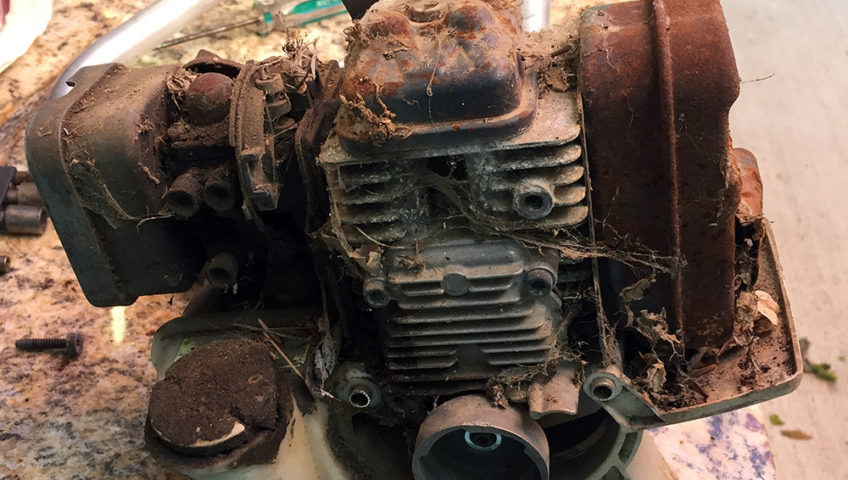Your string trimmer, or “weed whacker,” is a workhorse, but its tiny two-stroke engine is extremely sensitive to fuel delivery issues. Over time, the clear lines inside and outside the fuel tank become brittle, crack, or—most commonly—get stiffened and dissolved by ethanol in modern gasoline.
If your trimmer runs for a few seconds and then dies, bogs down under load, or if you see cracked lines near the primer bulb, it’s time for a vital, budget-friendly repair: replacing the fuel line and filter. This simple fix often revives a seemingly dead trimmer!
Why Fuel Lines and Filters Fail
The primary culprits behind fuel system failure in two-stroke small engines are time and ethanol.
- Ethanol Degradation: Standard rubber and plastic lines cannot handle the solvents in ethanol-blended fuel. They harden, crack, or swell, causing air leaks that starve the engine of fuel.
- Contamination: The small fuel filter (often called the clunk because it rests freely inside the tank) is the last defense before the carburetor. It captures rust, dirt, and line particles. If it clogs, the engine is starved.
What You Need for the Job
Before you begin, gather these essentials:
- New Fuel Line Kit: Small engines use different inner diameter (ID) fuel lines. Many generic kits come with several sizes (e.g., 3/32″, 1/8″, 3/16″) and a new filter, which is great for DIYers. Pro Tip: Look for Tygonor another high-quality, ethanol-resistant material.
- New Fuel Filter: The old filter is often the source of the clog. Always replace it.
- Needle-Nose Pliers or Hemostat: Essential for grabbing the line inside the tank.
- Utility Knife/Razor: For making clean, straight cuts on the new fuel line.
Step-by-Step Replacement Guide
Most weed trimmers have two lines running into the fuel tank through a rubber grommet on the side or top.
Step 1: Drain and Disassemble
- Drain the Tank: Empty all existing fuel into an approved container.
- Remove the Old Lines: This is the messiest part. Using pliers, gently pull the old, stiff lines out of the fuel tank grommet. Be sure to note which line goes where:
- Inlet/Supply Line: This is the longer line with the fuel filter on the end. It goes to the carburetor inlet.
- Return Line: This is the shorter line that goes to the primer bulb (or straight to the tank on some models). It dumps excess fuel back into the tank.
Step 2: Prepare and Feed the New Lines
- Cut the Inlet Line: Using the old line as a template, cut a new length of the correct diameter line (often the smaller one). Leave it long! It needs to reach the very bottom of the tank so the filter is always submerged in fuel.
- Install the Filter: Securely push the new fuel filter onto one end of the long inlet line.
- Feed the Inlet Line: Push the non-filter end of the line through the proper hole in the tank grommet. Once it’s through, use needle-nose pliers or a bent wire to gently fish the line and filter through the gas cap opening.
- Seat the Filter: Pull the line back just enough so the filter is resting at the very bottom of the tank. Cut the outside line to length so it comfortably reaches the carburetor connection.
Step 3: Connect the Return Line (If Applicable)
- Cut the Return Line: Cut a shorter length of the correct line. It only needs to stick into the tank about an inch to dump fuel.
- Feed and Connect: Push the line through its grommet hole. Connect the outside end to its corresponding port on the primer bulb or carburetor (consult your manual if unsure).
Step 4: Final Check and Test
- Connect to Carburetor: Re-attach the lines to the carburetor and primer bulb ports. Be gentle—do not force the connections.
- Refuel: Add fresh, properly mixed two-stroke fuel to the tank.
- Prime and Start: Press the primer bulb. You should see fuel moving through the filter and lines. If you see bubbling or if the bulb won’t prime, check your connections and the grommet seal.
By taking the time to replace these brittle, clogged parts, you’ll ensure your weed trimmer gets a clean, steady flow of fuel—revitalizing its power and eliminating those frustrating startup and running issues!

